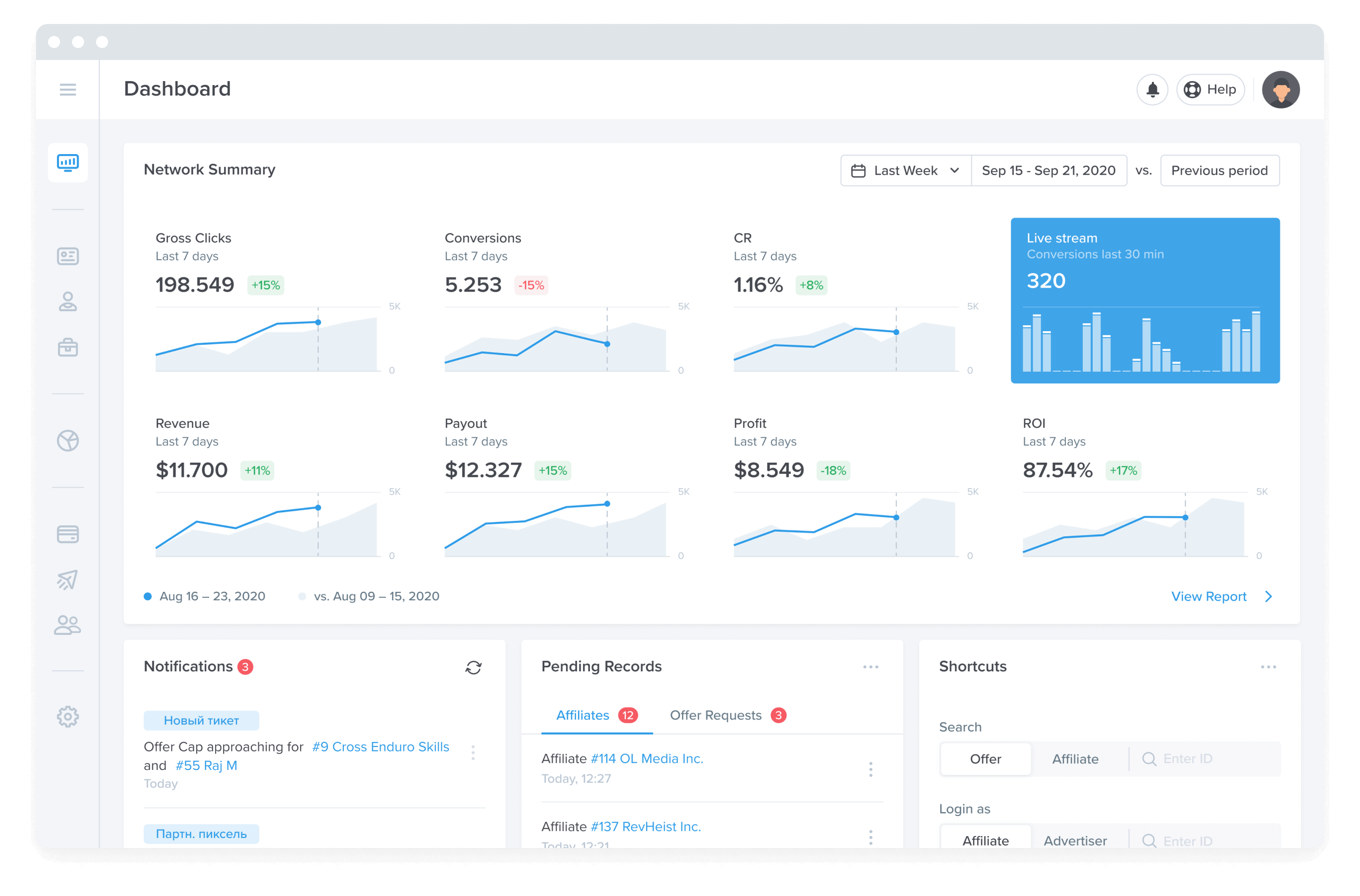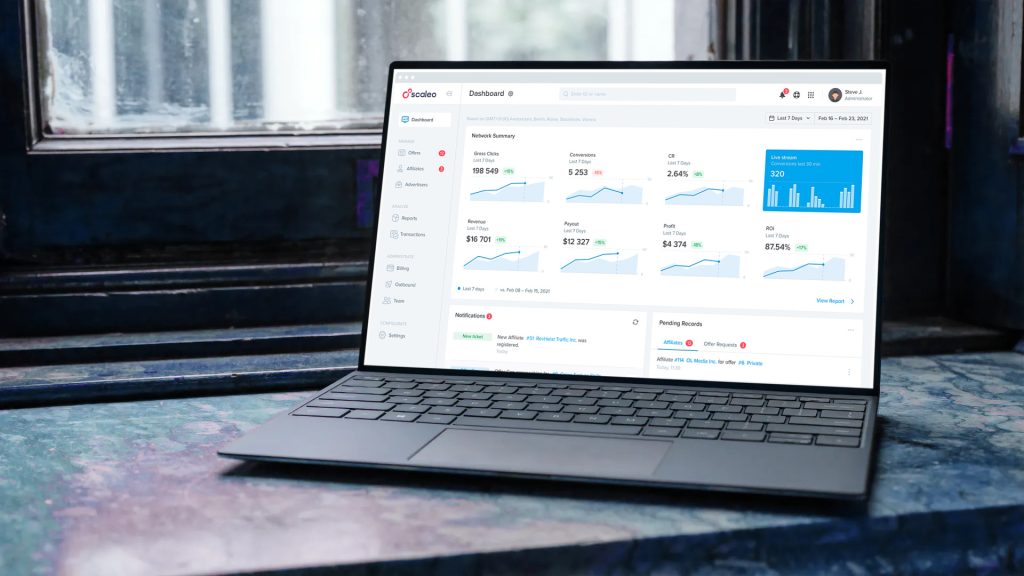Affiliate management is a difficult task. It’s not about having a large number of affiliate marketing program members who may or may not share your links. It’s not about having a well-known influencer mention your product, which may or may not result in conversions.
Instead, it all comes down to building the right relationships with the right types of affiliates.
Table of contents
That being said, you don’t have to wait until you’ve reached a critical mass of customers before investing in affiliate marketing. Actually, with the decline of print and display advertising, businesses in a variety of industries have adjusted their online strategies to generate revenue through affiliate marketing.
Many entrepreneurs are eager to take advantage of this type of business, which allows them to work from home and earn a good profit margin without having to purchase physical goods or make other investments. As a result, businesses are eager to promote their products or services through affiliate marketing.

An affiliate is not required to create a product, maintain a website, or even conduct sales operations. Instead, all affiliate marketing opportunities revolve solely around promoting links that serve as product recommendations for other people’s products.
This post will teach you everything you need to know about running this type of program and how to work with affiliates more effectively.
How do you create an affiliate program?
Normally, the first piece of advice in affiliate marketing is to choose a vertical, but since you already have a product, this is not the case. Along with strategic affiliate planning, the technical side of affiliate program implementation is a major decision that must be made.

We are currently observing a growing trend among many brands to transition away from working with agencies and running their partner programs independently. Working with an intermediary or independently is heavily influenced by the tracking technology you select.
Do you already know what services and additional tools you’ll need to set up and manage an affiliate program? In the following paragraphs, we will go over the various options available to you in the affiliate industry. If you already have a tool or a few in mind, it’s worth comparing them all before making a final decision.
The decision to launch an affiliate program entails additional responsibilities and costs for the services required to run an affiliate program. Depending on the solution chosen, you will need to either conduct a thorough analysis of existing solutions or devote significant time to business analysis and software development from the ground up.
There are three options for running a partner program:
- Make use of a SaaS affiliate platform such as Scaleo
- Participate in an affiliate network.
- Create an in-house solution from the ground up.
Affiliate program – step by step creation

Creating your partner program on a separate platform, contrary to popular belief, does not imply being in charge of the technology. Certainly not. Advertisers must select an affiliate management platform, just as they must select an affiliate network.
Affiliate tracking and management platforms are designed specifically for affiliate programs, including all necessary functionality. Once you have a subscription, you can create your program in the same way that you would on the network.
The main difference is that you are now the program owner and have access to all ad campaign data.
Advertisers win in terms of accuracy and accessibility to deeper analytics, which is important in ad campaign optimization. After repeating the advertising process for a while or even using the services of affiliate networks, advertisers frequently decide to create their own programs. In addition, new advertisers who anticipate a high volume of affiliates and ad campaigns consider launching their campaigns immediately on the SaaS platform.
How do I get started with an affiliate SaaS platform?

- You register on the vendor’s website.
- Sales or product representatives contact you to learn more about your program and to assist you in setting up an account.
- Typically, affiliate platforms provide a free trial period during which you can determine whether the platform is compatible with your program and meets our expectations. The trial period can range from 7 to 30 days, depending on the platform.
- During the free trial period, your program is fully functional. You can begin running advertising campaigns. You create a new offer, configure tracking, define target groups, and add advertisers and affiliates. You can change the settings along the way.
How do you pick affiliate software?

Third-party service integrations
Other services will most likely be required for the operational workflow. Examine the platform’s existing integrations. Pay special attention to the most popular services, such as fraud prevention, billing services, CRM, eCommerce platforms, BI tools, and so on.
Personalization
For some, customization may appear unimportant at first, but it will make a difference in the long run. In general, customization is divided into three levels: incorporating a company’s brand and design, system configuration for specific operational processes, and the possibility of implementing new modules.
The best option is to use a platform that supports all three levels. As a result, you can be confident that the platform will continue to meet your needs as your company grows.
Technical Assistance

In any tech business, tech support is critical – you are never alone with your program. Prompt assistance from tech support can save you a lot of time when figuring out how to handle certain configuration issues. Also, look for support that is available 24 hours a day, seven days a week. For example, ad campaigns do not have a consistent eight-hour workday and can be more effective in the evenings and at night.
Analytical Services
Analytics is a critical component of any affiliate program. Based on the data collected, advertisers can decide what worked and what didn’t and accordingly update future campaigns.

Adaptable API
If you want to integrate with a specific operational service that isn’t yet “plugged” into the platform, the integration will be based on API terms. On the other hand, future integrations will be a breeze if a platform provides a feature-rich API.
The Cost
The cost of “renting” a SaaS platform is calculated monthly and is primarily based on the number of clicks, conversions, or revenue generated or expected to generate per month. Remember that there may be additional fees for additional services or future integrations.

Don’t be alarmed if you see tracking solutions beginning at $29. These are trackers that affiliates can only use to track clicks. They can range from $29 to several thousand dollars, depending on the number of clicks and domains.
However, if you are launching your own program, this is not a viable option. You require a more advanced solution like Scaleo that allows you to manage advertisers and affiliates, optimize ad campaigns, and build your own network – you require a full-scale affiliate management solution. It can cost anywhere from $299 to thousands of dollars.
Invest your money wisely.
Financial management is one of the most difficult challenges for companies of all sizes. Unfortunately, few entrepreneurs have the technical knowledge required to manage resources properly. Don’t be concerned if this is also the case for you. When managing an affiliate program, there are two basic points to consider: how much commission to offer and how to continue making money while supporting your affiliates.
We won’t go into detail on these points right now. Still, if you want to control your cash flow, know which campaigns produce satisfactory financial results, track multiple campaigns at the same time, or assign commissions, Scaleo can help. Its types of commission feature allow you to track campaigns that are running across an unlimited number of websites and domains.
Monitoring and measuring performance efficiency.

The three previously discussed aspects, planning, marketing, and finances, must all be managed. This component will tell you whether the strategies you co-created with affiliates in each of the previously mentioned areas are successful.
But, in the end, how do you run an affiliate program? First, you must employ the proper metrics. There are several types, and some can provide very similar answers. So knowing what to measure and how to do it correctly is the key.
The key to managing affiliate programs is to ensure that their actions effectively yield positive results. To accomplish this, you must average each affiliate’s conversion and analyze the strengths and weaknesses of their performance.
If they are performing well, you can continue monitoring and motivating them (by increasing their commission, for example). Conversely, suppose you notice that their overall performance is significantly lower than expected. In that case, you can either guide them to improve their results or make more significant changes to your cooperation model.
With Scaleo, you’ll have access to features that allow you to monitor and measure the performance of each campaign, making it simple to track your affiliates’ progress. This includes:
- Affiliate link methods,
- Personalized affiliate tracking codes,
- Fraud protection,
- Multiple tracking methods,
- A variety of comprehensive reports to track the performance of your affiliate program.
Plan your affiliate strategy.
Planning is the key to business success.
You must plan your actions if you want to create a successful affiliate program and manage it consciously rather than haphazardly. A good place to start is to create a work schedule that specifies how much time you are willing to spend collaborating with affiliates.
It’s also a good idea to assign specific tasks to your affiliates, such as writing blog posts. This strategy will assist them in maintaining their focus and remaining productive and efficient.
However, keep in mind that planning entails more than just making a plan. You should also set financial goals to help guide your collaborative work. First, you must develop a commission structure that you can offer to affiliates and profit margins that should be met in both the short and the long run.
Following that, you must consider what actions you and your affiliates must take to achieve all of these objectives. Then, put them on paper (or use your favorite project management tool) and get organized so you can truly focus on achieving your goals – that is the secret to growth!
Consider Scaleo if you need advanced affiliate software to track affiliate programs and networks.

Scaleo has various features, such as a customizable interface, smart links, mass payments, and multiple affiliate program administrators, to make managing your program simple.
Simply put, these features allow you to plan and monitor all aspects of your affiliate program.
If you want to achieve your goals with an affiliate program, you must be aware of (and emphasize to affiliates) the fact that link promotion is purely marketing. It is therefore critical to employ the appropriate tools, strategies, and techniques.
Choosing products that are appealing to a specific audience

Your affiliate should choose the right products to promote now that they have defined their customer profile. The key is to identify the most relevant items to the client, such as digital products that are most useful in their niche.
Scaleo provides its users with an extensive library of promotion materials. You can use these resources to provide discount coupons, flash banners, HTML banners, lightbox banners, SmartLinks, text link banners, and other content to your affiliates.
Creating content and keeping the website up to date
One of the most important secrets to the success of websites, blogs, and social media profiles is content creation. Creating high-quality content is what ensures a devoted following. The key is to create compelling copy and messages with interesting and useful content. These messages will entice customers to visit pages where they can find links to products you promote via affiliate marketing.
Encourage affiliates to create high-quality, useful content.
When first starting out, your affiliate should target a specific market. The more specific and narrowly focused it is, the better. That’s called a micro niche. For example, a website or blog that is part of an affiliate program should not mix advice for two different consumer groups to achieve the best results. You shouldn’t, for example, mix bodybuilder ads with messages for animal lovers.
Even if both audiences have common interests, it is better to target a specific consumer profile and tailor your communication to that audience.
The benefit of segmentation is that affiliates can be more targeted in their strategies for spreading the word about your product.
Investing in paid advertisements

Many affiliates are unwilling to work with paid ads because they are expensive. On the other hand, a successful affiliate understands that ad costs should be viewed as an investment rather than a cost. This strategy almost guarantees a significant increase in reach, which directly correlates to an increase in conversions. Paid ads usually result in more clicks on affiliate links, higher conversion rates, and increased sales and profits.
Diversification of channels
To communicate with customers, an affiliate must use a variety of channels. For example, you should ask your affiliates to use social media, forums, or other places on the Internet where their potential customers are present and active, in addition to a website.
Email marketing and physical advertising are also used by successful affiliates (which works very well in specific cases). Remember that regardless of the channel you use for promotion, high quality is essential! Consumers today expect visually appealing pages and advertisements with high technical quality and no spelling or grammatical errors.
Affiliate Marketing Program Manager

Affiliate marketing entails far more than the typical marketing campaign. It is a continuous process that necessitates establishing and maintaining links, monitoring, improving, anticipating, and adapting to market trends.
Consider your program as a garden to better understand why you require an affiliate marketing program manager. Assume you hire the best gardener to trim your plants and give your garden a beautiful appearance. Unfortunately, weeds will eventually take over and ruin everything unless you have a gardener to maintain that look and care for the flowers.
The garden, of course, is your affiliate marketing program. Your affiliate program manager is the gardener. Regardless of how good your affiliate program is when you first set it up, all of your efforts and initial investments will be for naught without proper management.
Consider the flowers and weeds as your affiliates if you still don’t see the danger of running your affiliate marketing program on autopilot. You recruit only valuable affiliates when you set up your affiliate program, and your program looks great.
“Bad” affiliates are automatically approved when there is no affiliate marketing program manager to review and approve affiliates. As a result, they may discourage the “good” affiliates and even harm your brand through their dishonest practices such as bidding on trademarks in paid search, cookie stuffing, forced auto clicks, registering domain names with your brand name, and so on).
Now that we’ve established that you require the services of an affiliate program manager let’s look at what an affiliate program manager actually does.
What is the Role of an Affiliate Program Manager?
Affiliate program managers are also known as affiliate managers. This latter term implies that they only manage affiliates. That is not correct.

Affiliates are unmanageable. They are your partners, not your employees, and you have no control over them. All you can do is ensure that they follow the rules and policies of your program and encourage them to continue promoting your brand, products, or services.
An affiliate manager literally “manages” your relationship with your affiliates. They, however, do much more than that. Here’s a quick rundown of their main responsibilities:
- Create and maintain an appealing program description.
- Manage the creation and updating of creatives.
- Make and expand an affiliate database.
- Develop and maintain positive, energizing relationships with your affiliates.
- Use blog posts and newsletters to communicate with and engage affiliates.
- Execute and track marketing campaigns
- Affiliates must be identified, recruited, and activated.
- Create, implement, and track affiliate promotions.
- Identify and implement new opportunities to improve your affiliate program.
- Keep your affiliates up to date on new products and program enhancements, and encourage them to keep promoting your brand.
- Keep track of affiliate sales and manage payments on time.
- Intelligence and competitive analysis
- Examine and approve all pending transactions
- Compile a list of FAQs for potential and current affiliates.
- Represent and defend your program’s interests within the company, among other things.
Yes, an affiliate program manager performs all of these tasks and more. However, if we were to categorize all of their duties and responsibilities, five of them would be considered the pillars of affiliate program management.
1. Recruiting
Affiliates do not just appear anywhere; you must actively seek them out. If you decide to hire one, your affiliate program manager will be in charge of this. It may require half of their time, but it will be worthwhile. Unfortunately, your program is akin to launching a website and then abandoning it at the bottom of search engine results pages, where no one can find it without affiliates.
2. Onboarding
The mere fact that a publisher has applied to join your program does not guarantee that they will promote your products or services—it your affiliate program manager’s responsibility to persuade them to do so. A process is known as activation.
We suggest activating affiliates in 3 stages:
- The recruitment phase entails encouraging affiliates to join the program, begin promoting your products or services and generate their first leads/sales.
- In the welcoming phase, affiliates are encouraged to actively promote your products or services in the application approval email.
- The routine phase entails launching aggressive campaigns to entice those affiliates who have already joined your affiliate program but are not promoting your products or services yet.
3. Rule Requirement
Even if you have clearly prohibited certain affiliate behaviors, this does not guarantee that all of your affiliates will comply. It takes a vigilant and experienced affiliate marketing program manager to identify and punish those who do not.
4. Communication

Communication with affiliates is critical to the success of your program and is an essential component of affiliate marketing program management. It is the program manager’s responsibility to:
- Maintain positive relationships with current affiliates and motivate them.
- Keep affiliates up to date on new products or services and any future enhancements to the affiliate program.
- Manage communication campaigns as well as affiliate correspondence.
5. Development & Improvement
To ensure your program’s long-term success, you must measure its performance, analyze it, and take corrective action. Your affiliate program manager will handle everything. They will monitor the behavior of your affiliates and competitors, as well as the levels of satisfaction of your customers, and they will identify and capitalize on new opportunities to improve your program.
Your affiliate program’s performance will be determined by its manager’s education, experience, knowledge, skills, and abilities. The tools and resources will also determine it at their disposal. Finding a capable and dependable manager for your program is the best way to ensure its success.
You’ll have two choices: manage your affiliate program in-house or outsource it. Each option has advantages and disadvantages.
SaaS solution vs. in-house affiliate software – what’s better?
What should you choose? With so many options on the market, it’s clear that going with the first option is a safer, faster, and easier way. The SaaS platform is simply a better choice. The main arguments are that it is faster and less expensive.
Of course, proponents of in-house solutions will emphasize their transparency and security. However, tech providers can’t exist with today’s security and privacy regulations unless they perfectly meet data security and privacy requirements. That should not deceive you. Consider the time it would take to create a solution from scratch. Not to mention the time it takes to find specialists who understand exactly what an affiliate partner platform should include.
Conclusion
Even though we have only touched on the basics, implementing these strategies will assist you in managing all of your active affiliate programs that promote your products or services.
It takes time to become an affiliate marketer. First, focus on establishing the fundamentals with your affiliates. Set new goals and continue to experiment as your program grows. This is how you can create an affiliate program that will eventually generate a significant income. Finally, find time to try and make an informed decision, especially with SaaS platforms’ free trial period.
Scaleo provides a 14-day free trial with full onboarding. You can start your affiliate business right away!
Last Updated on April 10, 2024





